Disclaimer: LiTime sent this product to us for free for a review. That does not affect our opinion about the product. In this article, we list both what we like and dislike. Read more about this here.
LiTime’s Mini Battery Carries The Same 100Ah Capacity In A Smaller Package
LiTime, formerly known as Ampere Time, has released a new battery it calls the 12V 100Ah Mini.
Also available on Amazon (click to view)
While the specifications are very similar to their 12V 100Ah battery (one I reviewed a couple of months ago), the Mini is advertised as a more compact battery.
See Also: Timeusb Lithium Battery Charger Review
LiTime asked me to do a review of the new Mini, so I have put it through the tests to see if it performs as well as their previous battery did.
LiTime 12V 100Ah Mini – Specifications & Features
Battery Cells
LiTime use the lithium iron phosphate (LiFePO4) cells, which are both very durable and safe to use.
One big benefit with LiFePO4 batteries is that they lose total capacity slower than for example Li-Ion batteries.

Unfortunately, this battery is not capable of self-heating, so if you plan on using it in freezing temperatures, you need to make sure you’re still within these temperature ranges:
Charging: 32°F to 122°F (0°C to 50°C)
Discharging: -4°F to 140°F (-20°C to 60°C)
Storage: 14°F to 122°F (-10°C to 50°C)
Charging, discharging, or storing the battery outside of these temperature ranges can cause permanent damage.
Ratings – Ampere hours (amp hours) and watt-hours
The Mini battery is rated at 100Ah, which is 1280 watt-hours at 12.8V.
100Ah is also the max continuous charge/discharge current. In my tests I was able to discharge it at a higher rate than 100A, but I don’t recommend doing so. It might void the warranty to do so.
See Also: Vevor 2500W Inverter Review
As with all batteries, the state of charge depends on several factors, but here are some rough estimates that can be used to see how charged the Mini is based on its voltage.
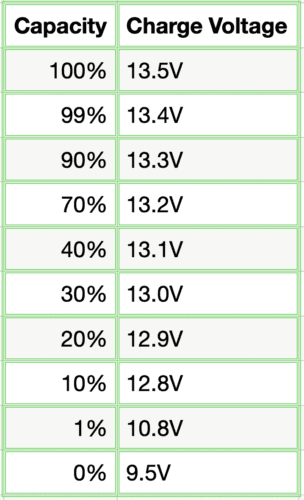
Safety features with built-in BMS
BMS stands for Battery Monitoring System, and is an essential part of any battery since it protects it when charging and discharging the cells.
The one in the Mini prevents overcharging, over discharging, overcurrent, and short circuits.
Cycle life
According to LiTime, expect at least 4000 cycles out of the battery before it reaches 80% of its original capacity.
One easy way to extend the life of a battery is to not completely discharge it very often. If you can keep it charged between 20-80%, you might get twice as many cycles out of it before it shows the same wear.
Expandability
A great feature with these batteries is that they support both parallel and series connections, meaning that you can combine two or more to not only increase amperage but also the voltage.
It supports 4S4P, which means four pairs of two batteries wired in series, and four pairs of two wired in parallel. That would be 16 batteries wired together.
Design and what’s included
The battery case is made of ABS plastic. That type of plastic is durable and heat-resistant.
It’s not waterproof, but it has an IP65 rating. That usually means dust and light rain won’t damage the product.
On top of the case, there is a built-in strap handle that makes it easy to carry and transport the battery.
On top is also where you will find the two battery terminals, one positive (red) and one negative (black).
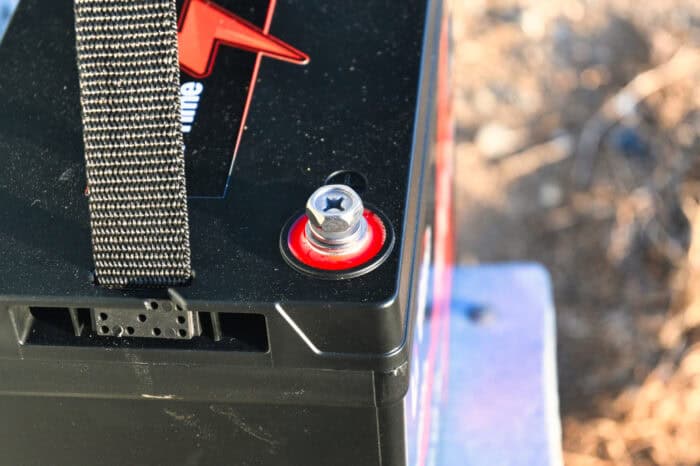
Size and weight
The LiTime 100Ah Mini measures 10.24 by 5.24 by 8.96 inches (26 by 13.3 by 22.7 cm) and weighs 19 pounds (8.6kg).
Review And Test Results
What I Like
Compact for a 100Ah battery
LiTime calls it Mini and advertises it as being the most compact 100Ah LiFePO4 battery on the market, and it is!
It’s quite impressive how compact it is, and it’s hard to believe it’s a 100Ah battery.
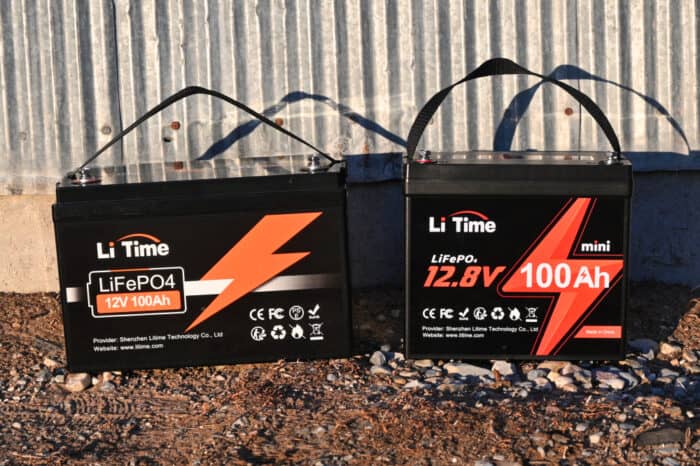
Not only is the form factor compact, but it’s also lightweight at 19 pounds.
A lot of amp hours for the money
In a capacity test I got a total of 103Ah, which is more than the advertised 100Ah.
While not as cheap as its bigger brother, the Mini is still very affordable and priced similarly to a high-end 100Ah AGM battery.
It’s possible to build an incredibly powerful power station for a fraction of the cost compared to only five years ago.
I was able to exceed the maximum continuous load
The manual states the max discharge current is 100Ah, which would be 1280 watts at 12.8V. But I could continuously draw 1800W without the battery overheating.
I used the Vevor 2500W inverter for my tests. Throughout all the tests, it read a steady 120V, and I didn’t see it drop once even when being stressed for an extended period.
You should not do this though, as there are reasons for the listed limit.
I don’t have the tools necessary to test the 100Ah maximum charging current. I charged it with a 20A lithium battery charger, and it took a little over five hours to reach a full charge.
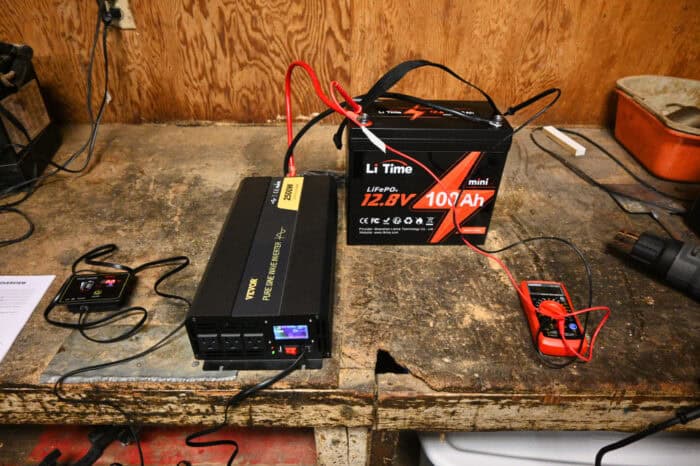
So much lighter than a 100Ah lead-acid battery
The Mini battery weighs 19 pounds, that is 49 pounds less than the 100Ah AGM battery I am currently using in my RV.
If I were to upgrade to four batteries, the total weight difference would be close to 200 pounds. Driving around with that extra weight would cost more fuel, and is another reason to invest in lithium batteries.
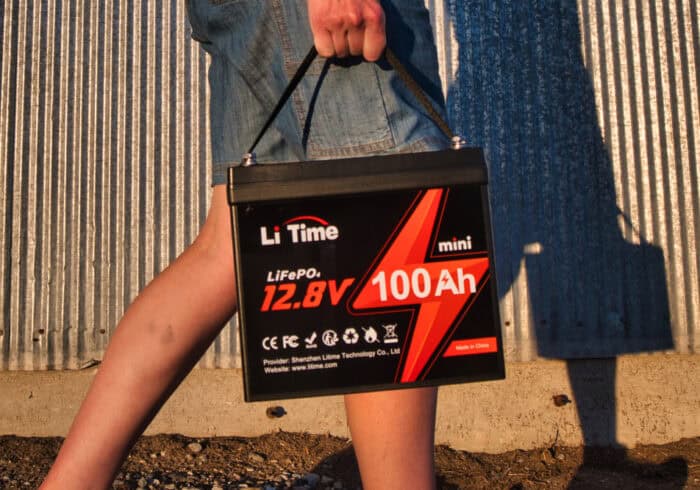
The durability of LiFePO4 batteries
The more common Li-Ion batteries found in most power stations are lighter, but not as safe and durable.
I prefer LiFePO4 because they’re usually rated around 3000-4000 cycles before reaching 80% of its original capacity. With Li-Ion batteries, that number is often around 500-800 cycles.
It goes without saying that a battery that you will get more use out of is better, but it’s important to understand how much better LiFePO4 is.
What I Don’t Like
No built-in heating or low-temperature protection
One big downside with this model is that it does not have any safety features that will heat or prevent damage from charging/discharging/storing the battery in too cold or warm temperatures.
That makes it important to be aware of what those ranges are. You risk damaging the battery permanently and voiding the warranty if you don’t.
Charging: 32°F to 122°F (0°C to 50°C)
Discharging: -4°F to 140°F (-20°C to 60°C)
Storage: 14°F to 122°F (-10°C to 50°C)
LiTime makes a model that can heat itself up, but the model I reviewed does not.
Some solar charge controllers can be manually set to stop charging if it senses a certain ambient temperature, but then the charge controller must be in the same area as the battery since temperatures vary.
Frequently Asked Questions
In the other LiTime battery review I did, I answered the most common questions related to lithium batteries. How to charge them, inverter recommendations, and whether you can replace an RV battery with one or not.
Click here to get to that review.
Please leave a comment down below if you have questions.



Can I lay this battery on its side or does it need to be upright?
Hi, this is what the manual says “Install the battery upright with post bolt facing up, and it could not be mounted upside down. If you need to mount the battery at its side, please contact service@litime.com to confirm the direction.”